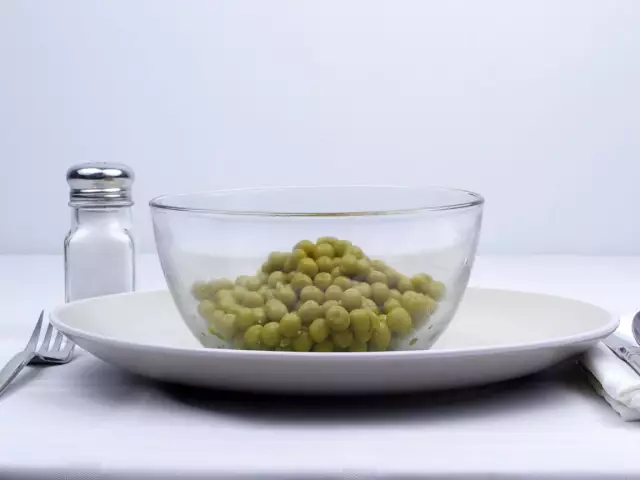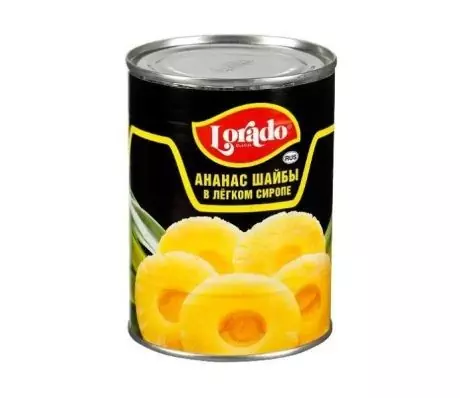- Author Rachel Wainwright [email protected].
- Public 2023-12-15 07:39.
- Last modified 2025-11-02 20:14.
Calorie content of peas

Peas are a herbaceous annual plant, considered perhaps the most popular member of the legume family.
Being one of the most ancient cultures (not less than 3000 years old), peas have been known for a long time in our territories and have entered folklore with the saying “it was still under Tsar Peas”.
This plant has earned high popularity for its beneficial properties - a large amount of vitamins A, B, C and PP, as well as the minerals that make up its composition (potassium, phosphorus, selenium and iron). Also, peas contain a sufficient amount of an amino acid important for the body - lysine, and the high protein content allows it to be considered an adequate substitute for meat dishes.
Peas also contain pyridoxine, which promotes the breakdown and synthesis of amino acids, which in turn prevents the development of dermatitis and seizures.
There are three groups of plant varieties. The calorie content of peas, its useful properties and the method of preparation depend on which group it belongs to:
- Shell peas with round peas and hard flaps are usually used for drying and further use in the preparation of various dishes - soups, mashed potatoes, side dishes. The calorie content of dried peas is 298-311 kcal per 100 g;
- In sugar peas, sweet, fleshy beans with slightly underdeveloped grains are especially prized. This variety is characterized by the fact that the seeds wrinkle during drying, which is due to the high moisture content of the raw seed;
- Fresh brain peas are also round in shape, but as they mature, they gradually shrink, resembling a brain. Due to the large amount of sucrose, they have a rather sweet taste. These varieties are most often eaten fresh or used for canning. They are considered unsuitable for heat treatment because they do not soften during cooking. The calorie content of brain peas is comparable to the calorie content of other fresh plant varieties.
Calorie content of peas, fresh and canned
It is not by chance that this plant was called "Tsar Pea" in Russia, since peas are widely used in the diet. It is eaten both raw and used as an ingredient in many different dishes, from cereals, soups, noodles and jelly to pea cheese.
In terms of nutritional value, energy charge and a fairly low calorie content, peas occupy a leading place among most vegetables. According to many nutritionists, at least 4 kg of a green pot should be eaten per year.
The calorie content of green peas varies from 81 to 84 kcal. Since fresh green peas contain proteins, vitamins, antioxidants and many useful minerals, it is recommended to eat them against the background of:
- Hypertension;
- Atherosclerosis;
- Chronic gastritis;
- Diabetes mellitus;
- Obesity;
- Peptic ulcer disease.
These beneficial properties of peas have been known for a long time, and Hippocrates advised eating it as an adjunct in the treatment of diseases of the cardiovascular system, anemia and goiter.
The low calorie content of green peas and its antioxidant properties, which reduce the likelihood of developing many heart diseases, as well as slowing down the aging process of the body, allow it to be included in the diet for both children and adults.
The calorie content of canned peas is only 55 kcal per 100 g, while maintaining all the beneficial properties of fresh beans. In canned form, doctors and nutritionists recommend adding peas to the diet of people with diabetes and diseases of the cardiovascular system.
Also, the low calorie content of canned peas makes them a useful ingredient in many vegetable salads. It is traditionally added to Olivier and vinaigrette. This allows you to improve the vitamin and mineral composition of these dishes, which is especially useful in the autumn-winter periods.
Calorie content of peas in dishes
Pea Soup refers to a dish whose main ingredient is dried peas. Due to its taste and low calorie content, pea soup in various variations can be found in traditional cuisines of many nations of the world. Depending on the variety of peas, its color (from gray-yellow to yellow), as well as calorie content, can vary. On average, the calorie content of pea soup (in 100 g) is 66 kcal.
Pea puree also refers to dishes that are prepared from dried peas, however, the calorie content of pea puree is slightly higher than that of soup, and amounts to 90-102 kcal per 100 g. Like other pea dishes, mashed potatoes are rich in proteins, which allows it to be included in the diet athletes. Also, the low calorie content of pea puree allows it to be included in various diets and fasting days, and if necessary, such porridge can replace some meat dishes.
Pea diet: pros and cons
There is an opinion that, despite the low calorie content, peas are not a dietary product due to unpleasant digestive symptoms, namely, the flatulence they cause. However, according to many nutritionists, peas can be used as part of a dietary menu due to their beneficial properties.
The main advantages of the pea diet include:
- Its good tolerance;
- Preservation of muscle mass;
- The ability to cook a variety of dishes;
- Balance of the main food components;
- The availability of foods that make up this diet;
- Ease of the principles of cooking, which allows even inexperienced cooks to follow it;
- Lack of hunger;
- The rejuvenating effect of following the pea diet, as well as improving the skin.

Pea dishes, especially in the form of porridge, are recommended to be eaten not only as part of a diet for weight loss, but also against the background of high blood pressure, anemia, anemia and kidney disease.
The main disadvantages of the pea diet include flatulence, which can occur when it is observed.
The pea diet is not a strict diet that requires you to eat only the foods it contains. Its main rule is to include at least one pea dish in the daily menu. The only condition is that the dish should not be high in calories.
For a week (the usual dietary time) due to the low calorie content of peas, you can reduce weight by 2-4 kg.
Despite the low calorie content of peas and its beneficial properties, there are a number of contraindications for following this diet. So, against the background of gout, inflammation of the stomach and intestines, as well as with acute nephritis, it is better to limit the use of peas.
Found a mistake in the text? Select it and press Ctrl + Enter.






